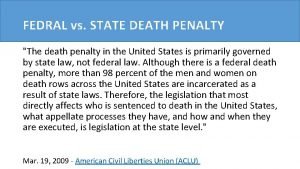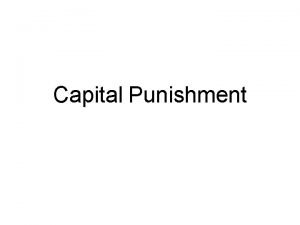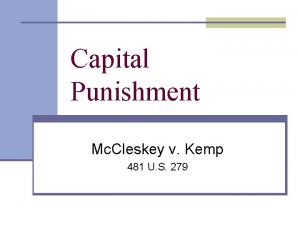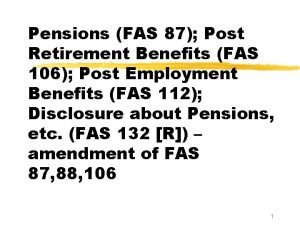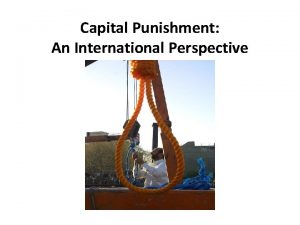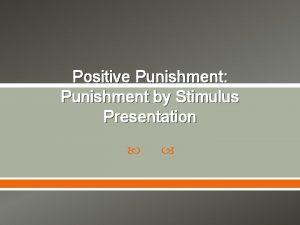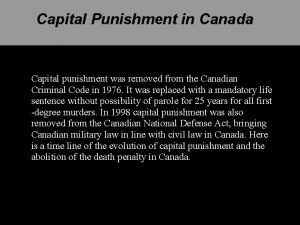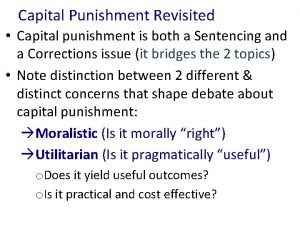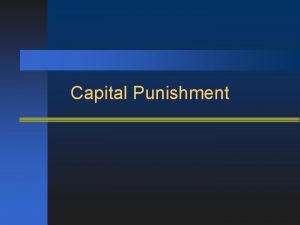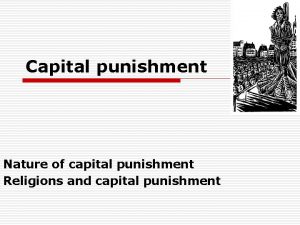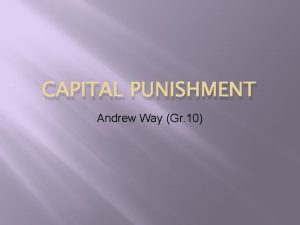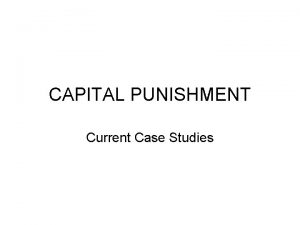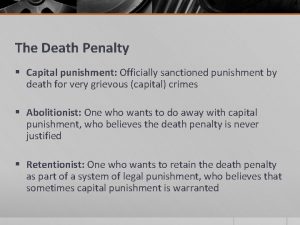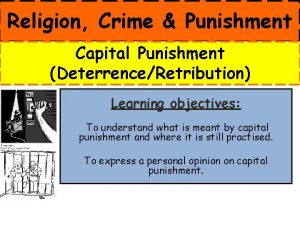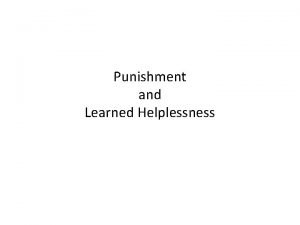Capital Punishment Capital Punishment International Perspectives 106 countries





















- Slides: 21

Capital Punishment

Capital Punishment: International Perspectives • • 106 countries have legally abolished all forms of capital punishment. 30 countries have pragmatically abolished the practice of capital punishment (no one on death row, no death sentences handed down in the last 10 years). 6 countries have abolished the death penalty for all crimes except treason and/or espionage. 53 countries still retain the death penalty. Roughly 20 – 25 countries/year carry out an execution. The United States is one of those countries that has the death penalty, but at this time, 22 states do not have the death penalty (nor does Washington, D. C. , Guam, Puerto Rico and the Virgin Islands), and 28 states do. There is a moratorium on the use of the death penalty in a number countries and American states (ie. , California, Malaysia).

Capital Punishment: An American Historical Perspective * The first person legally executed by civil authorities in American was Captain George Kendall in 1608 in what would become the State of Virginia (he was convicted of serving as a spy for Spain) * The first American state to outlaw the death penalty for all crimes except treason was Michigan (in 1846) * The first American state to outlaw the death penalty for all crimes was Rhone Island (in 1852) but it was re-instated in 1873 until again abolished in Rhode Island in 1984 * The first American State to permanently outlaw the death penalty was Wisconsin (in 1853).

Capital Punishment: An International Historical Perspective * Venezuela was the first country to outlaw the death penalty (in 1863) * Burkina Faso is the latest country to outlaw the death penalty (in 2018) * The first legal reference to the death penalty as a state-sanctioned penalty appeared in the Codes of Hammurabi (around 1750 BC) * The first documented state-sanctioned legal execution (vs. post-battle slaughter) was in 1550 BC in Egypt

Capital Punishment: International Experience • Large numbers of executions are carried out by these seven countries, but exact figures are not available – China, Indonesia, Nigeria, North Korea, Sudan, Syria, Taiwan • The largest number of executions each year are thought be carried out by China (around 1, 000), but as noted above, exact figures are not available • Roughly 95 percent of all documented legal executions annually are carried out by Iran, Saudi Arabia, Vietnam, Iraq, Egypt and the U. S. • 686 individuals were executed in 18 countries in 2018 (excluding data from the seven nations noted above) • Roughly 22, 000 persons are currently on death row, worldwide (again, excluding data from the seven nations noted above)

Capital Punishment: The American Experience • 29 states legally retain the use of the death penalty, as well as the U. S. federal government and the military • There have been between 21, 000 – 22, 000 legal executions since the mid-1600 s • There have been another 10, 000+ extra-legal lynchings • There were 7, 500 legal executions in the 20 th century • There have been roughly 1, 500 executions since 1967

Capital Punishment: The American Experience • There approximately 2, 600 people currently on death row • California has the largest number of individuals on death row (currently around 720) • Texas has executed the largest number of persons since 1967 (roughly 575 to date) • There were roughly 400 wrongful capital crime convictions in the United States in the 20 th century. For every 8 individuals executed from 1992 to present, 1 individual has been released from death row

Capital Punishment: The American Experience • • • Nebraska has executed 23 persons since 1901, latest in August 2018 Nebraska current has 12 persons on death row (Tecumseh State Pen) There are roughly 60 persons on federal death row (Terre Haute, IN) There are 6 individuals on the U. S. Military prison’s death row (Fort Leavenworth, KS) The U. S. Military has executed 135 persons since 1918, and none since 1961. There approximately 50 females on death row There have been 16 females executed since 1967 (out of the roughly 1, 500 persons executed since then) First female executed in what would become the United States was Jane Chapman in then Territory of Virginia in 1632 First female executed in the United States of America was Mary Surratt in July of 1865 for her role in the Lincoln assassination plot.

Capital Punishment: The American Experience Methods of Execution: • Hung – 2 states • Shot – 3 states • Lethal Injection – 29 states, Federal and Military • Gas – 11 states • Electric Chair – 9 states (first in 1890) Internationally - stoning, beheading, stabbing and throat slitting

Selected Capital Offenses Selected capital offenses (laws vary by state): * First degree murder * Murder of a law enforcement official * Treason/espionage * Train wrecking * Aircraft piracy * Aggravated kidnapping * Aggravated assault by a prison inmate Note – no death penalty for the crime of rape

Footnote: Consensual Executions Since executions recommenced in 1977, there have been over 100 consensual or voluntary executions for a number of reasons: * Isolated, tough life on death row * Martyr syndrome (die for the cause) * Feel they deserve to die for what they did * Death wish

Key 8 th Capital Punishment Cases • Roper v. Simmons - the death penalty cannot be administered to those who were 17 years of age or under when the offense was committed • Atkins v. Virginia - capital punishment is not a suitable penalty for mentally retarded defendants; such a penalty is excessive, when involving mentally retarded defendants

Capital Punishment: The American Experience • Public sentiment for the death penalty peaked in the 1930 s when death sentences were handed down regularly, but no polls were taken at that time to give us the exact figures • Public sentiment moved in opposition to capital punishment in the aftermath of World War II and by 1966, public support for the death penalty was down to 42% • Public support rose thereafter, peaking in 1994 at 80% • Public support today is around 60% • The majority (60%) now supports life without parole vs. the death penalty • While the Courts listen to the body politic, no Federal Court has ever ruled the death penalty to be cruel and unusual and in violation of the 8 th amendment, and likely never will

Key 8 th Amendment Cases • Furman v. Georgia - the death penalty is not being administered equitably • Gregg v. Georgia - allows the death penalty to be administered as long as the capital sentence is not mandatory, aggravating and mitigating circumstances are considered, and a bifurcated proceeding is utilized

Key 8 th Amendment Cases • Mc. Cleskey v. Kemp - specific intent to discriminate against an individual must be demonstrated before that individual's death sentence can be set aside; intent over impact • Mc. Cleskey v. Zant - defendants are entitled to a limited number of habeas appeals in capital cases • Herrera v. Collins - newly discovered evidence demonstrating the actual innocence of the person sentenced to death does not provide automatic habeas corpus relief (ie. , a new trial)

Arguments in Favor of Capital Punishment • Just deserts perspective • Vengeance/revenge perspective • Specific deterrence

Arguments in Opposition to Capital Punishment • Brutalization phenomenon (no general deterrent impact) • Morally wrong to kill • Miscarriages of justice • Extreme socio-economic/ethnic bias

Cost of Capital Punishment The cost of capital punishment varies from state to state and from case to case, but it appears to cost the State roughly 6 to 10 times more to adjudicate a capital case and eventually execute the individual vs. proceeding with a non-capital murder case and administering (paying for) their life sentence.

Capital Punishment Arguments: In Sum • In Favor (micro): ▫ Just deserts perspective ▫ Vengeance/revenge perspective ▫ Specific deterrence • In Opposition (macro): ▫ Brutalization phenomenon (no general deterrent impact) ▫ Morally wrong to kill ▫ Miscarriages of justice ▫ Extreme socio-economic/ethnic bias • Cost Factors

Impacts on homicide rates if capital punishment is abolished: • Decreases in homicide rates in countries that abolish the death penalty (Canada; homicide rates dropped more than 25%) • Overly simplistic question. Changes in homicide rates are due to many factors, not just the presence or absence of a death penalty. More important factors are the strength of communal bonds (church, school, family), educational and employment opportunities, access to handguns, the socioeconomic inequity coefficient and overall poverty levels, and extent of the drug trade. The presence (or absence) of a death penalty loads very low in a regression analysis context.

Capital Punishment: International Perspective • Capital punishment has become a human rights issue world-wide and has superseded criminal justice policy contexts • Capital punishment is not a human rights issue in the United States but rather a deeply imbedded religious and hot-button political issue
 Capital punishment definition
Capital punishment definition Fedral
Fedral Capital punishment definition
Capital punishment definition Thesis statement for crime and punishment
Thesis statement for crime and punishment The baldus study
The baldus study Humanist beliefs
Humanist beliefs 106 spelled out
106 spelled out Fahrenheit 451 pages 45-65 summary
Fahrenheit 451 pages 45-65 summary Cs
Cs Irig chapter 10
Irig chapter 10 Mae 106 uci
Mae 106 uci Plt 106
Plt 106 106 pal
106 pal 106 signal brigade
106 signal brigade Error n-106
Error n-106 Section 106 compliance
Section 106 compliance Salmo 106
Salmo 106 Fas 87 pension
Fas 87 pension Kj 106
Kj 106 Iec tc 106
Iec tc 106 Iat 106
Iat 106 Round the factors to estimate the products
Round the factors to estimate the products

